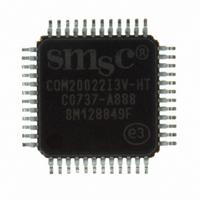COM20022I3V-HT SMSC, COM20022I3V-HT Datasheet - Page 12

COM20022I3V-HT
Manufacturer Part Number
COM20022I3V-HT
Description
IC CTRLR ARCNET 2KX8 RAM 48-TQFP
Manufacturer
SMSC
Series
ARCNETr
Datasheet
1.COM20022I3V-HT.pdf
(82 pages)
Specifications of COM20022I3V-HT
Controller Type
ARCNET Controller
Interface
Differential
Voltage - Supply
4.5 V ~ 5.5 V
Current - Supply
65mA
Operating Temperature
-40°C ~ 85°C
Mounting Type
Surface Mount
Package / Case
48-TQFP, 48-VQFP
Lead Free Status / RoHS Status
Lead free / RoHS Compliant
Other names
638-1004
Available stocks
Company
Part Number
Manufacturer
Quantity
Price
Company:
Part Number:
COM20022I3V-HT
Manufacturer:
Standard
Quantity:
2 784
Company:
Part Number:
COM20022I3V-HT
Manufacturer:
AD
Quantity:
7 439
Company:
Part Number:
COM20022I3V-HT
Manufacturer:
Microchip Technology
Quantity:
10 000
Part Number:
COM20022I3V-HT
Manufacturer:
SMSC
Quantity:
20 000
4.2.1
4.3
Revision 09-27-07
Selecting Clock Frequencies Above 2.5 Mbps
To realize a 10 Mbps network, an external 80 MHz clock must be input. However, since 80 MHz is the
frequency of FM radio band, it is not practical for use for noise emission reasons. Therefore, higher
frequency clocks are generated from the 20 MHz crystal as selected through two bits in the Setup2
register, CKUP[1,0] as shown below. The selected clock is supplied to the ARCNET controller.
This clock multiplier is powered-down (bypassed) on default. After changing the CKUP1 and CKUP0 bits,
the ARCNET core operation is stopped and the internal PLL in the clock generator is awakened and it
starts to generate the 40 MHz or 80 MHz. The lock out time of the internal PLL is 8uSec typically. After
more than 8 μsec (this wait time is defined as 1 msec in this data sheet), it is necessary to write command
data '18H' to the command register to re-start the ARCNET core operation. This clock generator is called
“clock multiplier”.
Changing the CKUP1 and CKUP0 bits must be one time or less after releasing a hardware reset.
The EF bit in the SETUP2 register must be set when the data rate is over 5 Mbps.
Network Reconfiguration
A significant advantage of the COM20022I is its ability to adapt to changes on the network. Whenever a
new node is activated or deactivated, a NETWORK RECONFIGURATION is performed. When a new
COM20022I is turned on (creating a new active node on the network), or if the COM20022I has not
received an INVITATION TO TRANSMIT for 210mS, or if a software reset occurs, the COM20022I causes
a NETWORK RECONFIGURATION by sending a RECONFIGURE BURST consisting of eight marks and
one space repeated 765 times. The purpose of this burst is to terminate all activity on the network. Since
this burst is longer than any other type of transmission, the burst will interfere with the next INVITATION
TO TRANSMIT, destroy the token and keep any other node from assuming control of the line.
When any COM20022I senses an idle line for greater than 20.5μS, which occurs only when the token Is
lost, each COM20022I starts an internal timeout equal to 36.5μs times the quantity 255 minus its own ID.
The COM20022I starts network reconfiguration by sending an invitation to transmit first to itself and then to
all other nodes by decrementing the destination Node ID. If the timeout expires with no line activity, the
COM20022I starts sending INVITATION TO TRANSMIT with the Destination ID (DID) equal to the
currently stored NID. Within a given network, only one COM20022I will timeout (the one with the highest
ID number). After sending the INVITATION TO TRANSMIT, the COM20022I waits for activity on the line.
If there is no activity for 18.7μS, the COM20022I increments the NID value and transmits another
INVITATION TO TRANSMIT using the NID equal to the DID. If activity appears before the 18.7μS timeout
expires, the COM20022I releases control of the line.
INVITATIONS TO TRANSMIT are sent to all NIDs (1-255).
Each COM20022I on the network will finally have saved a NID value equal to the ID of the COM20022I
that it released control to. At this point, control is passed directly from one node to the next with no wasted
INVITATIONS TO TRANSMIT being sent to ID's not on the network, until the next NETWORK
RECONFIGURATION occurs. When a node is powered off, the previous node attempts to pass the token
to it by issuing an INVITATION TO TRANSMIT. Since this node does not respond, the previous node
times out and transmits another INVITATION TO TRANSMIT to an incremented ID and eventually a
response will be received.
CKUP1
0
0
1
1
CKUP0
0
1
0
1
DATASHEET
20 MHz (Up to 2.5Mbps) Default (Bypass)
40 MHz (Up to 5Mbps)
Reserved
80 MHz (Only 10Mbps)
CLOCK FREQUENCY (DATA RATE)
Page 12
10 Mbps ARCNET (ANSI 878.1) Controller with 2Kx8 On-Chip RAM
During NETWORK RECONFIGURATION,
SMSC COM20022I
Datasheet













